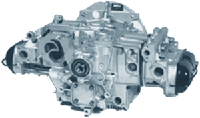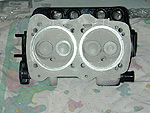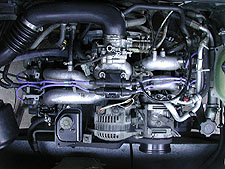 .
.| Upgrading Engine Performance |
 Introduction Introduction We
all know that the
stock T-3 Wasserboxer 2.1 petrol engine is underpowered. The WBX
can be modified to make it perform
modestly, but noticeably, better without giving up reliability. But let's face
it, the WBX will always feel underpowered compared to modern cars no
matter what you do
to it. For some, this is really not a problem. The engine
is
adequate, and even fun with a little tweaking and the right
gearing. For others, however, an engine conversion to a more powerful
unit is
the only solution.
The most popular conversions are to Subaru, VW I-4, Audi 5 cylinder, or TD or TDI diesel engines. The Subaru engines are now the most popular conversion in the US. Diesel conversions are more popular in Europe, but are catching on in the US.
..  The
Wasserboxer The
Wasserboxer
The
Wasserboxer. The
2.1 WBX is a horizontally opposed engine that delivers a nice, smooth
and broad power band with good torque at
low RPMs. It's a reliable
engine if maintained to spec and if preventative
. maintenance is performed. Fuel injection wear items like the
airflow meter,
the O2 sensor, the
temp
II sensor, and the idle switch must be replaced at some point after
90,000
miles. Water pumps should be replaced every 50,000 miles.
Use only OEM filters, fluids and parts.
maintenance is performed. Fuel injection wear items like the
airflow meter,
the O2 sensor, the
temp
II sensor, and the idle switch must be replaced at some point after
90,000
miles. Water pumps should be replaced every 50,000 miles.
Use only OEM filters, fluids and parts.Despite
its positive
attributes, the
WBX is definitely under powered. Some shops offer souped up
2.1
WBX engines that boast significant horsepower increases, but there have
been more than a few reports of reduced reliability in some of these
engines, so do your research before buying. As a general rule,
the more tweaked an engine is, the less reliable it is, and often the
power band is narrowed toward the top RPM range rather than broadened
toward the bottom, as would be preferred with a syncro.
Modest improvements in performance can be obtained without sacrificing reliability. Balancing the flywheel and clutch can  greatly increase smoothness. Ceramic coating the heads
prevents leaky gaskets resulting from corrosion and
helps contain
combustion temperatures for better breathing. Ceramic coating the headers
does the same. If the engine is torn down for
rebuild, the pistons crowns should also be ceramic coated. A free-flowing
muffler (Part Number 17783, some minor mods
necessary) and air filter will
also help improve breathing. 1.25
ratio rockers are used by some in pursuit
of improved low rpm torque.
Chrome molly push rods help lighten the valve train. (There was a
modified ECU chip available for a while, but it narrowed
the power band, with a resulting loss of power at the bottom end and an
increase
at higher RPMs (4000+).)
greatly increase smoothness. Ceramic coating the heads
prevents leaky gaskets resulting from corrosion and
helps contain
combustion temperatures for better breathing. Ceramic coating the headers
does the same. If the engine is torn down for
rebuild, the pistons crowns should also be ceramic coated. A free-flowing
muffler (Part Number 17783, some minor mods
necessary) and air filter will
also help improve breathing. 1.25
ratio rockers are used by some in pursuit
of improved low rpm torque.
Chrome molly push rods help lighten the valve train. (There was a
modified ECU chip available for a while, but it narrowed
the power band, with a resulting loss of power at the bottom end and an
increase
at higher RPMs (4000+).)These
modest upgrades
make the WBX smoother, externally cooler running,
noticeably perkier and more fun to drive. Performance can be
further enhanced by slightly lowering the gearing. Lowering
gearing modestly broadens the power band, increases
the available power at any given RPM and increases acceleration.
This translates into a slightly quicker van that can pull
hills better without as much down shifting, but one which loses roughly
4 MPH in cruising speed at the top. You can still cruise at 70
MPH on the interstates, but gas mileage will suffer. For dirt
roads, secondary roads and two-lane highways, however, the gearing is
much improved. A syncro with a WBX and geraing thus tweaked will
perform adequately and be enjoyable to drive for many if not most
syncronauts. Of course, it will not have the power of a good
conversion, though.
 Gas
Conversions Gas
Conversions The VW Vanagon Westfalia is nearly perfect for our every need except for its ability to climb even modest grades at speeds traveled by the owners of almost every auto built over the last 40 years. Because of this and the perceived poor engineering by some, many Vanagon  owners have experimented with other
engines.
owners have experimented with other
engines. Second, the engine performs very well. Since boxer motors of all types are inherently balanced and Subaru engines use a counterweighted crankshaft, they run very smoothly. The engine is so balanced that it happily turns 6500 rpms with no problems. They are also powerful. The least powerful of all the Subaru engines used in Vanagons, the EJ22, puts out 130 hp. More importantly, and unlike the in-line VW conversions, it has 80% of its available torque at 2000 rpm, which is especially important in a syncro. And with the range of Subaru engines that will fit in a Vanagon, you can get up to 250 hp out of a stock motor if you so desire. Finally, the Subaru
engines have superior technology and construction. These engines have a
very stout water pump and timing belt which show almost no discernible
wear at 100k miles. These are the same parts that have long been
problematic on VW engines. Subaru engines also use five full size
main bearings, four valves per cylinder and a much better engine
management system than VW. They have distributor less ignition and
continuous drive belts instead of v belts. Parts availability
should also be a factor in any conversion. Subaru parts are very
available everywhere in the US.
Ah yes, there must be
some drawbacks, aren't there? Of course. A Subaru conversion will take
longer to get done that an in line 4 VW which can be done in a little a
day or two. Any Subaru conversion takes at least 40 hours of work. Also
the Subaru is quite a bit more technically challenging for the
do-it-yourselfer than some other conversions. Cost is also a
factor. In most instances a Subaru conversion will cost more than a VW
gas engine conversion, but significantly less than a TDI conversion.
 Diesel
Conversions Diesel
Conversions There are many
advantages to a TD or TDI diesel conversion for a syncro. The
modern diesel engines put out tremendous amounts of torque at low RPM,
get about 30% better gas mileage and can cruise all day at 70+
MPH. There are downsides, though. First is cost. At a
minimum, it is about 20% more expensive to do a TD or TDI
conversion. There are few shops set up to do them. And it
is a daunting do-it-yourself job. In addition, the diesels do not
accelerate as well as some of the gas conversions. Some diesel
conversions vibrate and are noisy. And passing emissions
standards can pose hurtles in states like California. But still,
a properly done TDI conversion is an appealing option if you can afford
it.
 Here are photos of Stew's (UK) TDI
conversion performed by Brend
Jaeger in Germany. Stew and his wife stopped by for a visit
on their trip from Argentina to the Arctic Ocean in Alaska. Here are photos of Stew's (UK) TDI
conversion performed by Brend
Jaeger in Germany. Stew and his wife stopped by for a visit
on their trip from Argentina to the Arctic Ocean in Alaska.
|
|
|
 |
© 2004
All Rights Reserved
|